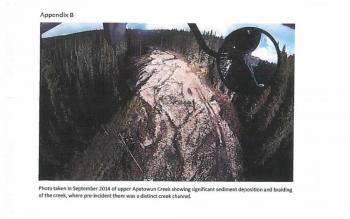By Shari Narine
Windspeaker.com Contributor
HINTON, Alta.
Fines nearing $4.5 million have been levied against Prairie Mines & Royalty ULC for an estimated 670 million litres of contaminated waste water that broke free from a dyke at the Obed Mountain mine and made its way into the Athabasca River on Oct. 31, 2013.
It’s not the highest fine faced by industry, but it is substantial, said Marie Breiner, coordinator for the Keepers of the Athabasca.
“The judge pointed out and the prosecutor brought up that this case was fined this high so that it can act like a warning or a sample case that can be used in the future to say, ‘If you pollute, you pay,’” said Breiner.
The fines were issued June 9, when Prairie Mines (formerly known as Coal Valley Resources Inc.) operators of the Obed Mountain coal mine, pled guilty nearly four years after the disaster. Facts of the spill, agreed upon by the mining company, the federal government and the province, were filed in Hinton Provincial Court.
Prairie Mines was sentenced under the federal Fisheries Act and fined $3.5 million and under the provincial Environmental Protection Act and fined $925,000. Prairie Mines will pay $2.15 million to Canada in trust to the “Environmental Damage Funds” and $1.15 million to a trust to be managed by the University of Alberta to create the Alberta East Slopes Fish Habitat and Native Fish Recovery Research Fund.
Of the provincial fine, just over $730,000 will be used toward “two creative sentencing penalties,” including $370,000 to the Environmental Education for Indigenous Youth Project. The project works with Alberta public educational institutions and communities within the Athabasca River Basin to identify, develop and deliver programs or courses that meet the needs of students from Indigenous communities and their respective communities.
Breiner, who was in court last week, was pleased with Judge C.D. Gardner’s comments.
“The judge was very in favour of First Nations and the impact it has on First Nations’ relations to the land,” she said, noting that the community impact assessment statement from the Mikisew Cree Nation was read aloud. “I thought that was really … good that it’s being acknowledged.”
Other First Nations impacted by the breach include Alexander First Nation, Alexis Nakota Sioux Nation and Athabasca Chipewyan First Nation.
However, Breiner is concerned that the Alberta Energy Regulator was not held accountable. She noted that the AER inspected Dyke E a month before the dam broke and the water level was at capacity already.
“I’m worried about the trustworthiness of the protocols the AER have to inspect dams because there are quite a lot of them in Alberta,” she said.
The agreed upon facts stated that inspections by employees indicated that water levels were either “full” or “high” during the week leading up to the dyke’s breach. While seepage at the dyke was noted, no action was followed through to deal with it. “Dyke E failed catastrophically,” says the agreed upon facts.
The result was 670,000 cubic metres of water and 90,000 tonnes of sediments released into Apetowun Creek, which joins with Plante Creek, which empties into the Athabasca River.
According to the facts, “the flow from the initial release would have been a significant physical hazard to persons or wildlife in the path of the flow… (but) there is no evidence of actual harm to humans or wildlife other than assumed impacts to fish and invertebrates.”
At this point, catch and release of fish remains in place for Apetowun Creek, Plante Creek and a large portion of the Athabasca River as measures to protect and aid in the recovery of the fish population.
Alberta Health confirms the mining company’s health assessment that the “potential impact on onsite workers, recreational users, residential communities downstream and First Nations…is not expected to result in acute or chronic effects on human health.”
Breiner says everyone was fortunate. Had the level of metals in this tailings pond been as high as in other tailings ponds and considering the way the dyke burst “it could have been fatal for people … anything in its path.”
The mine is the process of being decommissioned and reclaimed.

